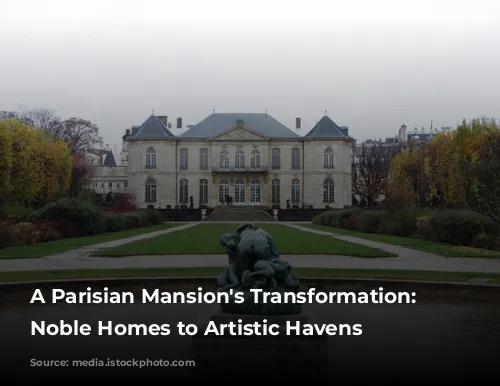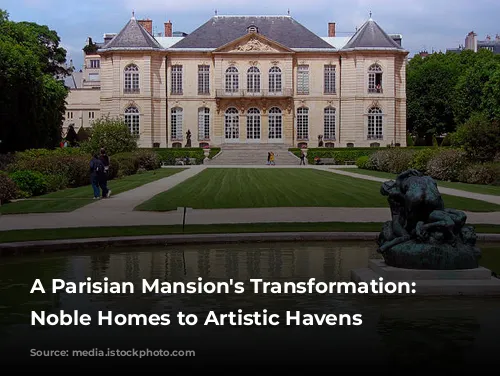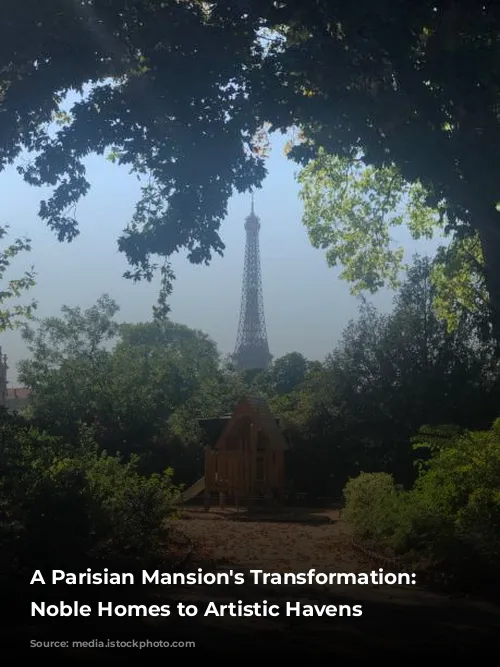The Hôtel Biron, a grand Parisian mansion with a rich history, has witnessed a fascinating evolution over the centuries. Its story, intertwined with the lives of prominent figures and changing tastes, is a journey through time.

A Noble Residence: The Hôtel Biron’s Early Years
In 1736, the widow of Abraham Peyrenc de Moras, the original owner, leased the mansion to the Duchess of Maine. While the exterior remained largely unchanged, the Duchess made significant alterations to the interior layout. Upon her death in 1753, the estate passed into the hands of Louis-Antoine de Gontaut-Biron, later known as Marshal Biron.
Biron’s impact on the mansion was primarily felt in the gardens, which he transformed into one of the most celebrated in Paris. He maintained the classic French garden design and the original plantings, but expanded the ornamental garden, added a circular pool, and created a section in the English style. The original kitchen garden remained but was moved to a different area of the estate. The appearance of these gardens during this era is well documented, thanks to detailed descriptions and engravings published in the late 18th century. The mansion itself came to be known as the Hôtel Biron, a name that endures to this day.
A Tapestry of Tenants: From Royalty to Religious Orders
After Marshal Biron’s death in 1788, the estate was occupied by a succession of owners and tenants. In 1795, the Duke of Charost turned the kitchen garden into an English-style garden, complete with a water feature. For almost a year, he rented the entire estate for festive gatherings inspired by the countryside, where the public could enjoy games, dancing, concerts, and fireworks.
Later, in the early 19th century, the mansion became home to papal legates and even the Russian embassy. In 1820, the Duchess of Charost sold the property to three nuns, including Reverend Mother Madeleine-Louise-Sophie Barat, founder of the Society of the Sacred Heart of Jesus. This religious congregation moved in and established a boarding school for girls.

A School’s Transformation: The Hôtel Biron’s Changing Identity
The nuns’ arrival ushered in a new era for the Hôtel Biron. The buildings and grounds were significantly remodeled to serve their new purpose as a school. Over time, the original decorations were dismantled and sold to wealthy collectors to finance the renovations. The garden lost its ornamental character, becoming a kitchen garden, orchard, and pastureland.
The sisters added new buildings for teaching and worship, most notably a chapel designed by Jean Juste Gustave Lisch and completed in 1876. In July 1904, the Society of the Sacred Heart of Jesus was dissolved, forcing the nuns to leave, and the estate was placed under the control of a receiver.

An Artist’s Haven: The Hôtel Biron’s Artistic Renaissance
The estate was put up for sale, but while awaiting a buyer, the Hôtel Biron was occupied by tenants from 1905. Among them were several prominent artists, including the writer Jean Cocteau, the painter Henri Matisse, and the dancer Isadora Duncan. The sculptor Auguste Rodin, introduced to the estate by Clara Westhoff, a future wife of the poet Rainer Maria Rilke, was particularly drawn to the property.
In 1908, Rodin rented four south-facing rooms on the ground floor with access to the terrace for his studio. The wild garden made a strong impression on Rodin, inspiring him to display his works and collection of antiques amongst its greenery. By 1911, he had taken over the entire estate.
From a grand Parisian mansion to a noble residence, a school for girls, and finally, an artist’s haven, the Hôtel Biron has witnessed a captivating transformation throughout the centuries. Its story is a testament to the changing tastes and lifestyles of different eras, and the enduring impact of remarkable individuals who have left their mark on this historic property.

